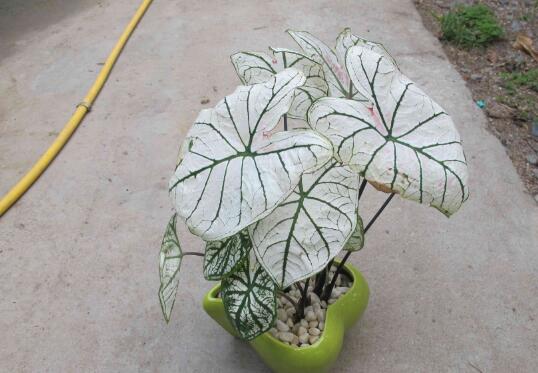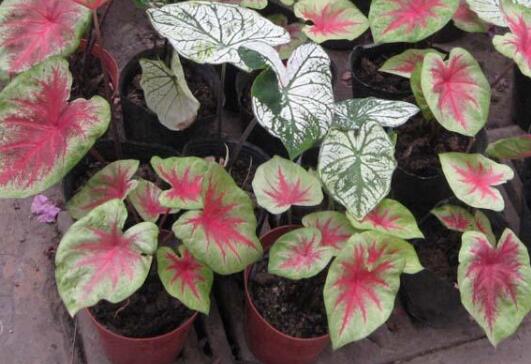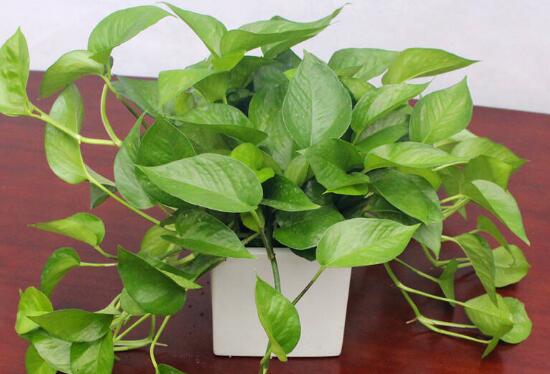The maintenance method of flower and leaf taro after autumn, pay attention to the 6 steps to grow better in the coming year.
Taro is a plant native to the Amazon River Basin in South America, which was introduced to China. Now it can be seen in many parts of our country. This kind of plant is not intolerant to low temperature, so it is necessary to pay attention to the maintenance of taro after autumn, so what is the maintenance method after autumn? Next, the editor will take you to learn about it.
The maintenance method of taro after autumn, pruning in time after flowering.

Summer is the viewing period of flower and leaf taro, and the leaves will gradually wither after the viewing period. At this time, we need to prune some withered and yellow leaves in order to maintain their plant type and lay a good foundation for the growth of the coming year. Of course, besides the first time, there are many places that need to be paid attention to. Let's introduce them one by one.
1. Pruning method
The leaves of taro will gradually turn yellow from October, and the petiole will droop, so we need to prune the yellowed leaves and disinfect the tools before pruning so as not to infect the plants with bacteria. After sterilization, just trim the withered leaves.
two。 Pay attention to water control
After the leaves of the taro begin to turn yellow, we need to control the amount of water. after all the leaves have withered, we can take them out of the flowerpot, dry them in the light for a few days, and then hide them in sand. Sand should be sterilized before sand storage.
3. Sand storage treatment
When storing taro in sand, it is best to keep the temperature above 10 ℃ and spray water on it every half a month or so to make the surface of the sand slightly moist. Here, we should pay attention to be careful when digging out its tuber, do not hurt it, otherwise the tuber will rot when stored in winter.
4. Spring treatment
In the early spring of the next year, we can take out the tuber of taro, then cut it into several pieces, and then put a little plant ash on the cut of the cut stem, which can prevent its decay.
5. Tuber planting
When planting tubers, we can choose humus soil with good drainage, and then add an appropriate amount of bone powder as base fertilizer, so that it can grow better, then plant the tubers and pour water through them, and then raise them in the shade. Wait until the emergence of the seedlings can be transferred to the semi-shade for maintenance. However, there is one thing we should pay attention to, that is, it is necessary to maintain a certain degree of humidity in the air when breeding.
6. Matters needing attention
When we plant tubers, we can put it face up, so that it will sprout more quickly, but the growth effect will not be very good. We can also put the back of its tuber up so that it will grow more neatly.
Post-autumn maintenance methods of flower and leaf taro
Post-autumn conservation of taro
Summer is the viewing period of taro, after the end of the viewing period, it enters autumn and winter, and winter is the dormant period of taro.
After dormancy, taro will germinate again at the end of spring, but before again, post-autumn care is needed, including autumn tube, winter storage and spring planting, so that it can grow normally in the coming year.
Nursing methods of flower and leaf taro after autumn
Generally speaking, the leaves of taro turn yellow from October, and the petiole wilts and droops. At this time, it is necessary to control watering, when all the leaves of taro wither, take it out of the flowerpot, put it in a better indoor light and dry place to dry for a few days, and then hide the sand, the sand should be sterilized first.
The temperature of taro sand storage should be kept above 10 ℃. Water should be sprayed every half a month, but it should not be too moist. The sand surface should be slightly moist. It should be noted that when digging up the tuber of taro, do not hurt the tuber of taro, otherwise it will cause the tuber of taro to rot when stored in winter.
In the spring of the following year, the stem of the flower-leaf taro was taken out and cut into several pieces for planting. The cut stem can be treated first to prevent its decay, and the incision can be smeared with plant ash.
When planting, you can choose rotten leaf soil, add some bone powder to make base fertilizer, plant the tuber well, then pour enough water and keep it in a dark place. Wait until the emergence of taro seedlings can be placed in a semi-shady place for maintenance. Attention should be paid to maintaining a certain amount of air humidity.
In addition, when planting tubers, you can choose to put the tubers face up, the germination is faster, but the growth effect is not good. You can also plant the tubers on the back of the taro, which will grow more neatly.
The family conservation experience of taro, Taro likes high temperature and humid environment, and is suitable for loose, fertile and well drained acid soil. When planting in pots, it is appropriate to use sandy loam rich in humus. After planting, with the growth of new leaves, the amount of water can be gradually increased. At this time, it is necessary to receive hours of scattered sunlight every day, and the ambient temperature is kept between 22 and 28 ℃. Adequate moisture should be maintained during the growing period, and the mature thin liquid fertilizer should be applied every 15 days or so, and the fertilizer liquid should not contaminate the leaves. When it is hot in summer, avoid strong sunlight and shade the leaves at noon to avoid burning leaves. Water once every morning and afternoon, pay attention to maintain a high air humidity, often spray water to the plant leaves and sprinkle water around the flowerpot. During the growing period, the old leaves that turn yellow and droop should be cut off in time, and if there are flowering stems, they should also be cut off in order to concentrate nutrients and promote new leaves. The flower-leaf taro tuber is safe to winter in this way: after ① enters the autumn, the flower-leaf taro tuber gradually goes into hibernation, and the leaves on the soil also wither one after another. at this time, the dead leaves of the tuber can be poured out of the basin, cut off, put in a ventilated place to dry, and then put into a basin filled with sand for dry storage. Sand should not be too dry or too wet, especially too wet, or it will rot. Put it in an indoor shade place, dig out the tuber from the sand basin after the next spring and plant it in other pots, but before planting in the basin, you should apply enough base fertilizer, which is very important for future growth and development. ② does not need to dig out the sand, but still stays in the original basin and moves into the indoor ventilated place to survive the winter. the basin soil should be dry and avoid being too wet. after the next spring, it can be knocked out of the basin and planted again (apply sufficient base fertilizer). Make the taro leaf shape big and colorful: in order to make the taro leaf shape big and colorful, the key lies in winter storage and spring planting. The key points of its maintenance: ① since September, taro leaves began to yellowing, gradually wilting and drooping, at this time should be controlled watering, stop fertilization. When all the leaves withered, the tubers were taken out in the buckle basin and dried in a good light, ventilated and dry place for several days, stored in sterilized dry sand without impurities, kept for more than 10 ℃, and sprayed with a spray can once every half a month to keep the sand surface slightly moist. When digging tubers, care should be taken not to damage the tubers so as not to rot during winter storage. ② in the early spring of the following year, take out the tuber, or peel off the surrounding small tubers and plant directly, but each piece must have at least one bud, and use charcoal or furnace ash to smear the incision antiseptic, basin soil with rotten leaf soil mixed with rotten chicken manure and bone powder, pour enough water and place in the shade, after emergence, move to semi-shade maintenance, pay attention to maintain the surrounding air humidity. There are two methods for ③ tuber planting, one is tuber facing upward, which can promote rapid germination, but the annual growth is unbalanced, and the main bud growth is particularly exuberant and prominent; the other is to plant tuber upside down, sprouting more slowly, but more and growing evenly. Fertilizer and water management: during the maintenance of taro, the potted soil should always be kept moist, the amount of topdressing should be appropriate, and do not apply thick fertilizer. The leaf life of taro is only 1 year. After the bud eye on the local lower stem is mature, it can sprout continuously and produce new leaves. Some rarefied liquid fertilizer can be applied properly when drawing new leaves, and there is no need to topdressing at other times. Otherwise, the petiole is too teahouse and not full enough, not only easy to break, but also loose in shape. Whenever new leaves are produced, topdressing should be stopped immediately and watering water should be reduced at the same time. When the plant enters the dormant state in winter, it should stop watering, but do not take off the basin, let the tuber survive the winter in the basin soil, and start watering again after the temperature rises in the coming year, prompting it to reproduce new leaves. The whole growth process of taro can be divided into two stages: growth period and dormancy stage. To make flowers and leaves taro leaves colorful, all the year round should be carefully managed, do a good job of maintenance. Families in northern China can take out the stored tubers from April to the beginning of May, peel off the small tubers around the large tubers, dry them a little, and then put them on the pot. For flowerpots with a diameter of about 25 cm, it is appropriate to plant 3-4 large tubers in each pot. For example, in order to expand reproduction, you can also use a sterilized knife to cut the large tuber into small pieces with 1 or 2 budding eyes, and the cut is coated with charcoal powder or plant ash and soot for anticorrosion, and put on the basin after the incision is dried. The basin soil should choose loose, fertile and slightly acidic soil with smooth drainage, generally 6 portions of rotten leaf soil or peat soil, 2 portions of garden soil and 2 parts of river sand, plus a small amount of bone powder or rotten cake residue as base fertilizer. Watering and fertilizing should be timely and appropriate. Spring and summer growth peak season, generally every 7-10 days to apply compound liquid fertilizer or all-element flower fertilizer, the color is bright. If too much nitrogen fertilizer is applied, the color spots on the leaves will fade, affecting the ornamental effect. Do not stain the leaves when applying liquid fertilizer so as not to scorch the leaves. Water in spring and autumn to keep the basin soil moist. If too much watering, and poor drainage is easy to cause tuber rot; such as too little watering, basin soil dry, easy to lead to leaf withering. The temperature is high in summer, the water evaporates quickly, and it is also in the vigorous growth period of taro. In addition to sufficient watering, it is necessary to spray water on the leaf surface and sprinkle water on the ground near the flowerpot for 2 or 3 times a day to cool down and humidify, which is very important to keep the leaves beautiful. Autumn is the stage of tuber growth and development, and it is necessary to apply more phosphorus and potassium fertilizer to promote tuber growth. When the temperature drops below 15 ℃ at the end of autumn, the leaves begin to turn yellow and gradually enter the dormancy period. At this time, it is necessary to reduce watering and promote the tubers to enter dormancy. The flower-leaf taro prefers semi-shade during the growth period and avoids strong light, which requires stronger light intensity than other shade-tolerant foliage plants. If the light is too weak, the plant is easy to grow, the leaf is thin and thin, and it is easy to lose its bright color and luster, but the light should not be too strong, because the young leaves are often easily burned because of the strong light. The light conditions required by different varieties are slightly different. Varieties with red patches and bright colors need more light. If there is not enough light, the color spots will fade. White varieties with thin leaves need less light, while strong light is easy to hurt the leaves. The family cultivates the flower leaf taro, in summer, it is appropriate to put the flowerpot indoors with good ventilation and bright light, so as to prevent the strong light from being exposed directly. Spring and autumn are placed in the semi-shade to keep the leaves bright. If there is a flowering stem, it should be cut off in time to reduce nutrient consumption so as not to affect the growth of leaves. When old leaves are found to turn yellow and droop, they should be cut off at any time to facilitate the germination of new leaves. The management of flower-leaf taro during dormancy must not be relaxed. if there is relaxation, freezing injury will affect the growth of the coming year, and the serious ones will not be able to sprout the following year, so the experts who raise flower-leaf taro attach great importance to overwintering management. The main points of management: first, the temperature should be suitable, and the other is that the matrix should be dry and wet properly. As long as we have a good grasp of these two points, we will lay a good foundation for growth in the following year. The specific method is to take out the tubers after the leaves of taro are withered and yellow, dry slightly and then bury them in the river sand for storage. If the number of tubers is small, it can not be taken out of the basin, but the tubers can be put indoors for the winter. During overwintering, the shelter should be kept dry and properly ventilated, and the temperature should not be too high or too low, so that it is safe to keep it at 14-17 ℃. Because it does not germinate or freeze in this temperature range, it is beneficial to survive the winter safely. The matrix of buried tuber should be dry and wet properly in order to maintain the fresh state of tuber, the matrix is too dry, it is easy to cause tuber drying and shrinkage, affecting the sprouting in the coming year; if the substrate is too wet, it is easy to cause tuber rot and lose the ability of germination, and it is better to keep the substrate slightly moist.
- Prev

How to raise taro, culture methods and matters needing attention / avoid stagnant water / avoid bright light
Taro is a highly ornamental plant, its leaf color is rich, very changeable, so it is loved by many people, many people want to raise one at home, so how to raise taro? What are the breeding methods and matters needing attention of taro? Next, the editor will take you to learn about it.
- Next

How to raise green radish spider orchid, green radish spider orchid cultivation methods and precautions/acid soil
Green radish, that is, we often hear green radish, it is a very beautiful and practical plant, not only can beautify our living environment, but also can effectively absorb harmful gases such as formaldehyde in the air. Such a plant naturally provokes many people to want to raise it. How can the green radish be raised?
Related
- Fuxing push coffee new agricultural production and marketing class: lack of small-scale processing plants
- Jujube rice field leisure farm deep ploughing Yilan for five years to create a space for organic food and play
- Nongyu Farm-A trial of organic papaya for brave women with advanced technology
- Four points for attention in the prevention and control of diseases and insect pests of edible fungi
- How to add nutrient solution to Edible Fungi
- Is there any good way to control edible fungus mites?
- Open Inoculation Technology of Edible Fungi
- Is there any clever way to use fertilizer for edible fungus in winter?
- What agents are used to kill the pathogens of edible fungi in the mushroom shed?
- Rapid drying of Edible Fungi

